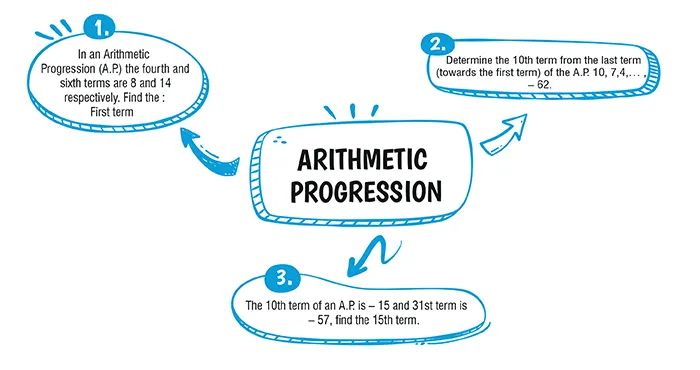Table of Contents

Ans. (c) 20
Explanation:
A.P. = 1,4,7,10………
Here, first term (a) = 1
And common difference (d) = 4 - 1 = 3
Let nth term of the given A.P. is 58.
⇒ 58 = a + (n-1)d
⇒ 58 = 1 + (n-1)× 3
⇒ n - 1 = \dfrac{57}{3} = 19 \\
⇒ n = 20
So, 58 is 20th term of the A.P.
Ans. (c)
Explanation:
\text{sum of 25 terms of an A.P.} \\[4.5 bp]
\dfrac{-2}{3}, \dfrac{-2}{3},\dfrac{-2}{3} is \\[4.5 bp]
= \dfrac{n}{2} [2a+(n-1)d] = \dfrac{25}{2} \\[4.5 bp]
\begin{bmatrix} 2 × \left(\dfrac{-2}{3}\right) + (25 - 1 ) × 0\end{bmatrix} \\[4.5 bp]
= \dfrac{}{}\begin{bmatrix} -\dfrac{4}{3}\end{bmatrix} = \dfrac{-50}{3}
Explanation:
Let, a and d be the first term and common difference of the given A.P.
Then, a_4 = 8 \space and \space a_6 = 14 \space (Given)\\
⇒ a + 3d = 8 ...(i)
and a + 5d = 14 ...(ii)
On subtracting equation (i) from (ii),
we get,
2d = 6
⇒ d = 3On putting d = 3 in equation (i),
we get,
a + 3 × 3 = 8
⇒ a = 8 – 9 = – 1
(a) First term (a) = – 1. Ans.
(b) Common difference (c) Sum of first 20 terms (S20) (d) = 3. Ans.
∵ S_n = \dfrac{n}{2} [2a+(n–1)d] \\[4.5 bp]
∴ S_{20} = \dfrac{20}{2} [2× (-1) +(20–1)×3] \\
= 10(-2 + 57 )
= 550.
Explanation:
Here a = 10, d = 7 – 10 = – 3
and last term l = – 62
10th term from the last term
i.e., n = 10
Required term = l – (n – 1) d
= – 62 – (10 – 1) (– 3)
= – 62 + 27
= – 35
Therefore, the 10th term from the last term is – 35.
Explanation:
Let a be the first term and d be the common difference of the A.P. Then from the formula :
t_n = a + (n–1)d,\\[4.5 bp]
\text{we have,} \\[4.5 bp]
t_{10} =a + (10–1)d = a + 9d \\[4.5 bp]
t_{31} = a + (31–1)d = a + 30d \\[4.5 bp]
\text{we have,}\\[4.5 bp]
a + 9d = – 15 …(i) \\[4.5 bp]
a + 30d = –57 …(ii)\\[4.5 bp]
Solve equations (i) and (ii) to get the values of a and d.
Subtracting (i) from (ii), we have
Download Mind Map of this chapter
Download NowWant to Practice Mock Tests of this chapter
Practice NowDownload Important Questions of this chapter
Download Now| Chapter No. | Chapter Name |
|---|---|
| Chapter 1 | Goods and Service Tax (GST) |
| Chapter 2 | Banking |
| Chapter 3 | Shares and Dividends |
| Chapter 4 | Linear inequations |
| Chapter 5 | Quadratic Equations in one variable |
| Chapter 6 | Ratio and proportion |
| Chapter 7 | Factorization |
| Chapter 8 | Matrices |
| Chapter 9 | Arithmetic Progression |
| Chapter 10 | Geometric Progression |
| Chapter 11 | Coordinate Geometry |
| Chapter 12 | Reflection |
| Chapter 13 | Similarity |
| Chapter 14 | Loci |
| Chapter 15 | Circles |
| Chapter 16 | Constructions |
| Chapter 17 | Mensuration |
| Chapter 18 | Trigonometry |
| Chapter 19 | Statistics |
| Chapter 20 | Probability |
| Chapter Wise Important Questions for ICSE Board Class 10 Mathematics |
|---|
| Goods and Service Tax (GST) |
| Banking |
| Shares and Dividends |
| Linear inequations |
| Quadratic Equations in one variable |
| Ratio and proportion |
| Factorization |
| Matrices |
| Arithmetic Progression |
| Geometric Progression |
| Coordinate Geometry |
| Reflection |
| Similarity |
| Loci |
| Circles |
| Constructions |
| Mensuration |
| Trigonometry |
| Statistics |
| Probability |
CBSE Important Questions Class 10
ICSE Important Questions Class 10
CBSE Important Questions Class 10
ICSE Important Questions Class 10